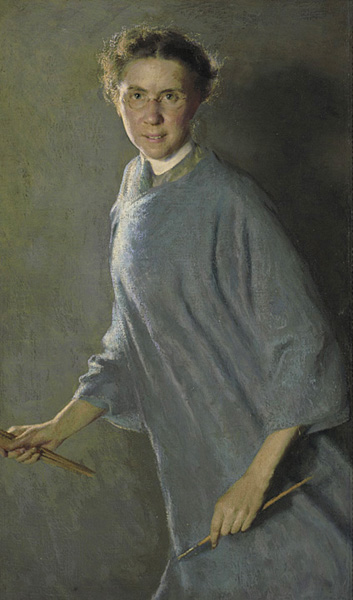
A Motion Picture
Margaret Foster Richardson
This unique self-portrait reflects changing attitudes toward women in the early twentieth century as well as an expansion of opportunities clearly embraced by the artist. Depicting herself as a working artist with paintbrushes in each hand, Richardson strides forward into the light, hardly slowing to meet the eye of the viewer. Richardson's direct gaze, knowing smile, and the work's sense of movement and vitality convey a self-confidence and professionalism associated with the era's so-called New Woman. In contrast to the Gibson Girl, the more decorative symbol of contemporary femininity, Richardson chose to depict herself with eyeglasses, a no-nonsense hairstyle, a painter's smock, and rather masculine collar and tie.
A native of Winnetka, Illinois, Richardson came to Boston for artistic training, studying with "Boston School" Impressionists Joseph De Camp and Edmund C. Tarbell. Primarily a portraitist, she found early success and won a number of awards. Not following the lead of her famous teachers, who tended to paint women as gauzy, vapid beauties, Richardson favored strong, active female sitters, including fellow artist Laura Coombs Hills and Mary Baker Eddy, founder of the Christian Science Church. As 'A Motion Picture" may imply, Richardson was known for painting her sitters so truthfully that many felt her portraits were unflattering. Unfortunately, Richardson's commissions dwindled with the Depression, and she closed her studio in 1943.
Artist
Date of Birth
(1881-ca. 1945)
Date
1912
Medium
Oil on canvas
Dimensions
40 3/4 x 23 1/8 in. (103.505 x 58.7375 cm.)
Accession #
1913.13
Credit Line
Henry D. Gilpin Fund
Copyright
No known copyright restrictions
Category
Subject
More by
We're so excited you're planning to visit PAFA!
Make time for art — visit us Thursday to Sunday.
Before reserving your tickets, please review helpful information about museum hours, accessibility, building access, and special admission programs.
If you have any questions, feel free to reach out to us at visitorservices@pafa.org — we’d love to help!